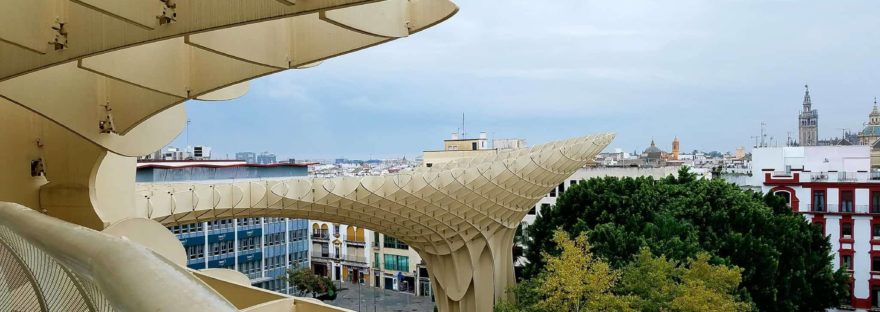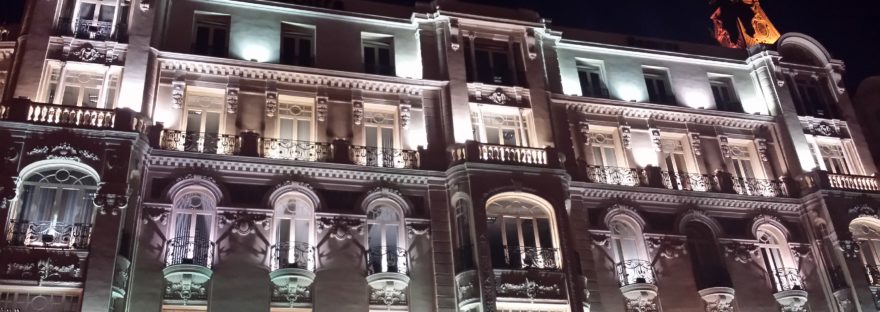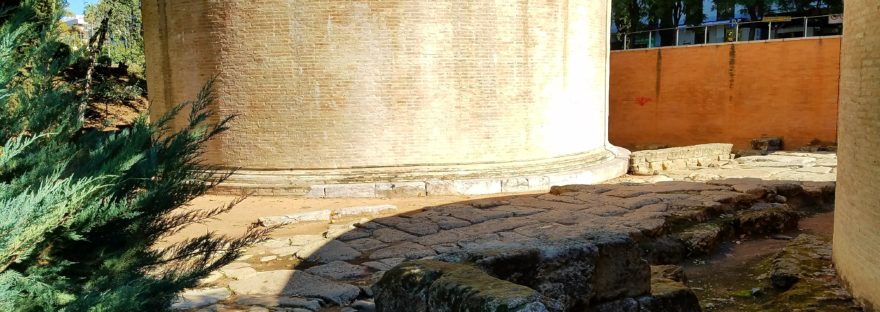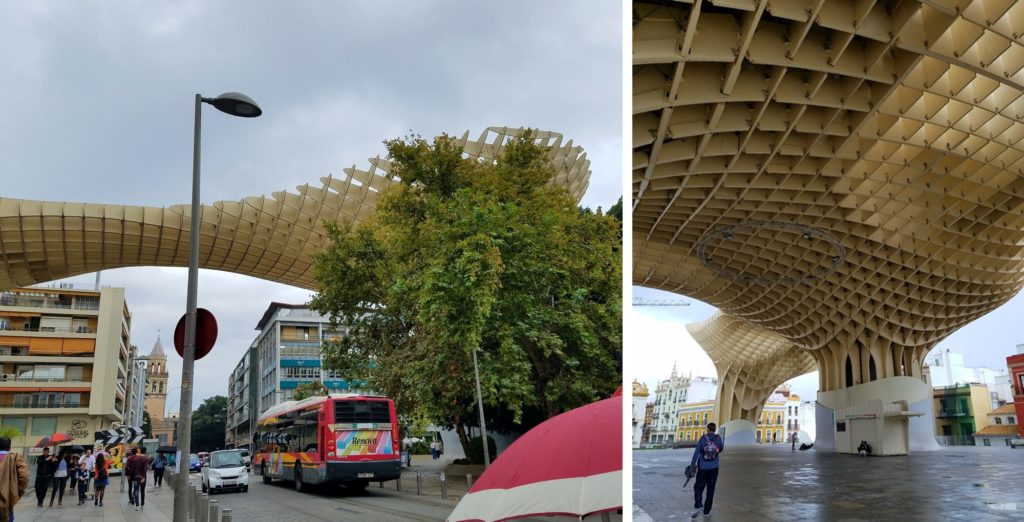 Frankly, we couldn’t imagine the enormous size of this structure. As we approached it we felt like Smurfs under these huge mushrooms. With much curiosity and skepticism we decide to discover what this large structure had to offer. Continue reading “The Mushrooms of Seville”
Frankly, we couldn’t imagine the enormous size of this structure. As we approached it we felt like Smurfs under these huge mushrooms. With much curiosity and skepticism we decide to discover what this large structure had to offer. Continue reading “The Mushrooms of Seville”
Category: Spain
Alfileritos Street
 “Alfileritos” Street in Toledo, Spain. We became very curious to know the origin of the name of this street and we now share what we have found. In Legends Toletum we find that “Alfileritos” is a long, narrow street lined with old houses and old palaces, which rises near the “Plaza de San Nicolas”, and dies at the “Plaza de San Vicente”, near the apse of the church of the same name. Continue reading “Alfileritos Street”
“Alfileritos” Street in Toledo, Spain. We became very curious to know the origin of the name of this street and we now share what we have found. In Legends Toletum we find that “Alfileritos” is a long, narrow street lined with old houses and old palaces, which rises near the “Plaza de San Nicolas”, and dies at the “Plaza de San Vicente”, near the apse of the church of the same name. Continue reading “Alfileritos Street”
The “Palacio de los Granados”
Our friends Paul and Francisco fell in love with Ecija and this eighteenth century structure in at first sight. Even though it had been closed for over 70 years, they took up the task of restoring it and turning it into the Palacio de los Granados in honor of the beautiful pomegranate trees found in the yard on that first visit. For us it meant our home on the days we visited Écija. Continue reading “The “Palacio de los Granados””
Finally in Madrid!
Our visit to Spain began in Madrid to later travel to Andalusia and return to Madrid. Therefore, we had a couple of days to explore the city.
Definitely, Madrid is a very cosmopolitan and modern city which holds many great treasures to visit. At the same time, it is the kind of place which can be visited a thousand times and there will always be something new to discover and new experiences to be lived. Continue reading “Finally in Madrid!”
The “Mihrab” of the Mosque-Cathedral of Córdoba
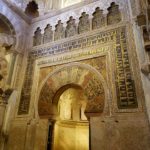 Inside the Mosque-Cathedral of Córdoba we will find the “Mihrab”. Continue reading “The “Mihrab” of the Mosque-Cathedral of Córdoba”
Inside the Mosque-Cathedral of Córdoba we will find the “Mihrab”. Continue reading “The “Mihrab” of the Mosque-Cathedral of Córdoba”
The Metropolis Building, Madrid, Spain.
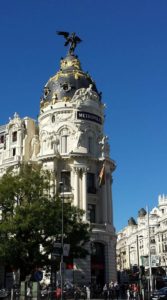 The Metropolis Building is considered to be the most emblematic of Madrid, Spain. Its actual physical address is 39 Alcalá Street, despite that many believe it is on the “Gran Via” (Grand Avenue). The building was designed by the famous French Architects Jules and Raymond Février by means of a contest. Various architectural styles were employed such as Roman, Beaux Arts and Neo-Roman. Its construction was ordered by the insurance company “La Unión y el Fénix” in 1907. Work was finally completed in 1910 under the eyes of the Spaniard Luis Esteve Fernández-Caballero. The building was inaugurated in 1911. Continue reading “The Metropolis Building, Madrid, Spain.”
The Metropolis Building is considered to be the most emblematic of Madrid, Spain. Its actual physical address is 39 Alcalá Street, despite that many believe it is on the “Gran Via” (Grand Avenue). The building was designed by the famous French Architects Jules and Raymond Février by means of a contest. Various architectural styles were employed such as Roman, Beaux Arts and Neo-Roman. Its construction was ordered by the insurance company “La Unión y el Fénix” in 1907. Work was finally completed in 1910 under the eyes of the Spaniard Luis Esteve Fernández-Caballero. The building was inaugurated in 1911. Continue reading “The Metropolis Building, Madrid, Spain.”
The Crystal Palace
The Crystal Palace found in the “Buen Retiro” Park is without a doubt, one of the most beautiful structures that can be found in Madrid. A structure that on one hand, combines subtle and romance, and on the other hand, an integration of innovative materials and monumental space providing an impressive attitude. Continue reading “The Crystal Palace”
The Columns of Mosque-Cathedral of Córdoba
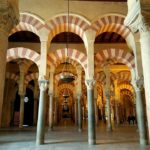 Upon entering the Mosque-Cathedral of Córdoba one might believe to have entered a forest, but instead of trees, one bows before one thousand three hundred columns of marble, jasper and granite. Continue reading “The Columns of Mosque-Cathedral of Córdoba”
Upon entering the Mosque-Cathedral of Córdoba one might believe to have entered a forest, but instead of trees, one bows before one thousand three hundred columns of marble, jasper and granite. Continue reading “The Columns of Mosque-Cathedral of Córdoba”
The Orange Grove of the Mosque – Cathedral of Córdoba
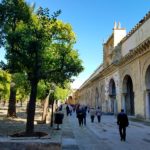 “A beautiful nursery of Orange Trees that catches one’s view upon entering that sacred temple”, this is how Fray Gregorio de Alfaro referred to the the Orange Grove or Garden of the Mosque – Cathedral of Córdoba in his writings towards the end of the XVI century.It’s name is derived from the 98 orange trees planted in rows. Continue reading “The Orange Grove of the Mosque – Cathedral of Córdoba”
“A beautiful nursery of Orange Trees that catches one’s view upon entering that sacred temple”, this is how Fray Gregorio de Alfaro referred to the the Orange Grove or Garden of the Mosque – Cathedral of Córdoba in his writings towards the end of the XVI century.It’s name is derived from the 98 orange trees planted in rows. Continue reading “The Orange Grove of the Mosque – Cathedral of Córdoba”
Roman Mausoleum of Córdoba
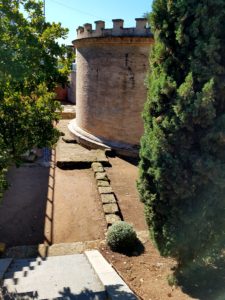 As we strolled through Córdoba, we unexpectedly encountered a large circular or cylindrical structure which turned out to be part of the Roman Mausoleums of Córdoba, a pleasant surprise. In researching the same, we discovered that this was of the most important funeral structures of the city built by the Romans and that they date back to the I Century. We observed that the same had be completely re-built and the burial hall containing Ash Urns as well as remains of its base, cornice and banisters . The Center for the Interpretation of the Funeral World is found therein and can be visited by appointment. Continue reading “Roman Mausoleum of Córdoba”
As we strolled through Córdoba, we unexpectedly encountered a large circular or cylindrical structure which turned out to be part of the Roman Mausoleums of Córdoba, a pleasant surprise. In researching the same, we discovered that this was of the most important funeral structures of the city built by the Romans and that they date back to the I Century. We observed that the same had be completely re-built and the burial hall containing Ash Urns as well as remains of its base, cornice and banisters . The Center for the Interpretation of the Funeral World is found therein and can be visited by appointment. Continue reading “Roman Mausoleum of Córdoba”

